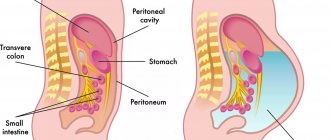Causes of stomach cancer and risk factors
The likelihood of developing a disease is affected by:
- presence of close relatives with a history of stomach cancer;
- stomach polyps or adenomatous polyposis;
- peptic ulcer and chronic gastritis;
- increased levels of Helicobacter Pilory;
- duodeno-gastric reflux;
- intestinal metaplasia - replacement of gastric epithelium with intestinal epithelium;
- unhealthy diet – large amounts of salty, spicy and smoked foods, animal fats, low content of vegetables and fruits;
- lack of vitamin C;
- consumption of low-quality and expired products;
- smoking and excessive alcohol consumption;
- age over 60 years, especially in men;
- period 5-10 years after gastric surgery.
Having risk factors does not mean you will definitely get sick. The absence of risk factors does not mean that you will definitely not get sick.
Contraindications
Laparoscopy is considered a minimally invasive method of surgery, which is less likely to cause complications than laparotomy and has a shorter recovery period. Since laparoscopy is still a method of surgical intervention, surgeons identify a number of limitations to its implementation.
Contraindications to laparoscopy:
- pregnancy;
- abnormalities in blood clotting;
- hemorrhagic shock;
- pathologies of the vascular system;
- heart disease;
- peritonitis;
- diseases of the respiratory system (acute period or chronic form);
- renal/liver failure;
- absolute intolerance to anesthesia.
Surgery for a diagnosis of stomach cancer requires complete control of the patient’s condition. In case of relative contraindications, if the risk of laparoscopy is less than the probability of death, a specialist can perform surgery.
Stages
According to the degree of malignancy and prevalence of the process, the stages of the disease are distinguished:
- 0 – single atypical cells are found only in the upper layer of the gastric mucosa;
- I – tumor cells affect the mucous and submucosal layers of the gastric wall.
Stage I is divided into substages:
- I A – only the submucosal layer is affected;
- I B – the muscular layer of the stomach is also affected, metastases were detected in 1-2 nearby lymph nodes.
Stage II is divided into substages:
- II A – the tumor spreads: to the submucosal or muscular layers of the gastric wall, metastases were detected in 1-2 nearby lymph nodes;
- submucosal layer with metastases in 3-6 nearby lymph nodes.
- II B – the tumor spreads: to the outer layer of the gastric wall;
- subserous layer of tissue under the outer membrane with metastases in 1-2 nearby lymph nodes;
- muscular layer of the gastric wall with metastases in 3-6 nearby lymph nodes;
- submucosal layer of the gastric wall with metastases in 7 or more nearby lymph nodes.
Stage III is divided into substages:
- III A – the tumor spreads: to the outer layer of the gastric wall with metastases in 1-2 nearby lymph nodes;
- serous layer of tissue under the outer membrane with metastases in 3-6 nearby lymph nodes;
- the muscular layer of the gastric wall with metastases in 7 or more nearby lymph nodes.
- to nearby organs - spleen, liver, diaphragm, kidney, adrenal gland, pancreas, transverse colon or small intestine with metastases to 1-2 nearby lymph nodes;
- to nearby organs - spleen, liver, diaphragm, kidney, adrenal gland, pancreas, transverse colon or small intestine with metastases to 3 or more lymph nodes;
Radiation therapy
Radiation therapy for stomach cancer is usually combined with chemotherapy, this treatment is called chemoradiotherapy. Computed tomography helps select the type and dose of radiation and the number of procedures. Markers on the skin or special marks inserted into the tumor tissue help to correctly “target” the rays at the tumor area.
Usually the procedure lasts 10 minutes, 3 hours before it you cannot eat anything. There are the following modern types of radiation therapy for stomach cancer:
- 3D conformal radiation therapy is a method in which, thanks to volumetric planning, the shape of the irradiated volume maximally matches the shape of the tumor and practically does not affect healthy tissue;
- Intensity-modulated radiation therapy is used in cases where radiation affects vital organs: liver, lungs, heart. In this case, the general beam is divided into separate rays, which can have different intensities.
Main symptoms
The first signs of the disease are discomfort and pain in the stomach, dyspepsia. In addition to them, in the early stages Source: Asymptomatic gastric cancer. Shut S.A., Platoshkin E.N., Dorogokupets A.Yu.: Problems of health and ecology, 2022:
- heartburn;
- nausea;
- decreased appetite;
- feeling of bloating after eating;
- discomfort in the upper abdomen;
- increased fatigue, weakness.
In later stages, symptoms of stomach cancer:
- vomit;
- black stool;
- belching;
- feeling of a full stomach;
- stomach ache;
- jaundice;
- ascites - an increase in abdominal volume due to fluid accumulation;
- weight loss.
Without treatment, complications of stomach cancer are possible - bleeding, tumor perforation, gastric obstruction, phlegmon.
Postoperative period
A patient diagnosed with stomach cancer requires long-term treatment and recovery. Laparoscopy, even with partial removal of an organ, ends with a difficult postoperative period, which is divided into two stages: primary and secondary.
The main stage of rehabilitation takes place in the first 10 days, during which the patient is under the supervision of specialists in the hospital. The patient begins to get back to his feet the very next day. Even minimal physical activity is necessary to speed up the recovery of the gastrointestinal tract, prevent the formation of blood clots, the development of infection in the lungs and other complications.
The main stage includes restoring the patient’s nutrition. Since the esophagus, stomach and upper intestine are injured, the patient cannot feed himself. To maintain the body, the patient receives nutrition through infusions. This type of nutrition involves the insertion of a nasogastric tube.
Complete removal of the intestines requires more complex techniques to maintain the body's nutrition. After the operation, a stoma formed from the small intestine is removed through an opening in the upper abdomen, which connects the peritoneum with the internal organs. A special catheter can be installed in the urinary tract, through which urine is removed.
Gradually, as the body recovers, the urinary catheter and nasogastric tube are removed. A special diet is prescribed (temporarily or for life).
To monitor the patient’s condition, after laparoscopy, the patient should regularly undergo preventive examinations for timely diagnosis of complications or possible relapse.
Diagnostics
To make a diagnosis, an endoscopic examination of the stomach is performed.
A probe with a miniature video camera and a light source is inserted through the mouth and esophagus. The procedure allows you to identify the location of the tumor. During its implementation, a biopsy is also performed - taking a tissue sample for histological analysis. The diagnosis is confirmed only after examining the tumor tissue under a microscope. To determine the exact size of the tumor, a CT scan is performed, sometimes with contrast enhancement. To assess the prevalence of processes, the condition of the lymph nodes and identify metastases, ultrasound is prescribed. To clarify the specific characteristics of the tumor, X-rays are taken with barium preparations.
Clarifying diagnostics helps to choose the most effective treatment tactics. Thus, a blood test for the HER2/neu gene mutation helps to select the most effective antitumor drugs. In addition, the following is prescribed:
- analyzes for tumor markers CEA and CA-19.9;
- intragastric ultrasound;
- positron emission tomography (PET).
Treatment methods
The main treatment method for stomach cancer is surgery. Radiation and chemotherapy are carried out additionally to increase the effectiveness of treatment Source: Combined treatment of stomach cancer. Afanasyev S.G., Tuzikov S.A., Davydov I.M.: Siberian Journal of Oncology, 2015. As monomethods for stomach cancer, they are ineffective and are prescribed if surgery is contraindicated.
Surgery
Surgical treatment is carried out at all stages of stomach cancer: in the early stages for radical removal of the tumor and complete recovery of the patient, in the later stages to improve the patient’s quality of life and reduce the severity of symptoms. The extent of the operation depends on the malignancy and extent of the tumor, the age and health of the patient Source: Surgical treatment of stomach cancer. Rakhov S.B.: Bulletin of the Kazakh National Medical University, 2012.
Gastrectomy – removal of the entire stomach with the tumor, surrounding fatty tissue and regional lymph nodes. During the intervention, partial or complete resection of affected neighboring organs is possible. After excision, an artificial anastomosis is formed - an anostomosis - between the esophagus and the small intestine.
Gastric resection, distal or proximal – removal of the affected upper or lower part with tissue and regional lymph nodes.
Endoscopic resection of the gastric mucosa - removal of the affected area of the mucosa through punctures without incisions. It is effective at the initial stage of the oncological process, as well as in elderly and weakened patients for whom full-fledged surgery is contraindicated due to their condition.
Palliative stenting is the installation of a special stent that provides lumen to the stomach. Indicated for patients in later stages to ensure unhindered digestion.
Gastroenteroanostomosis is a palliative surgical treatment to restore the lumen of the outlet from the stomach into the intestine.
Chemotherapy
Treatment with drugs that destroy cancer cells or block their division. The simultaneous administration of several such medications - polychemotherapy - allows you to reduce the dosage of each of them and the negative side effects of treatment, and increase its effectiveness. Prescribed before or after surgery.
Radiation therapy
Using X-rays to destroy tumor cells or slow their growth. Indicated before or after surgery, for metastases in the lymph nodes, in late stages and when surgical treatment is impossible. For precise focusing (to kill the tumor without affecting nearby tissues), CT marking is used.
Causes
Stomach cancer
is a malignant neoplasm that develops from altered cells of the gastric mucosa.
The stomach is an organ that is daily, many times exposed to the aggressive effects of hydrochloric acid produced by the organ’s own cells. Nature provides several levels of “protection” from acidic effects on the gastric mucosa. But often a person deliberately undermines defense mechanisms.
Stomach photo
Here are the factors that reduce the effectiveness of the protective properties in the gastric mucosa:
- "Unhealthy food. Bitter, salty or very sour foods, preservatives, coffee, carbonated drinks, foods that are too hot or too cold, coffee, alcohol. All this irritates the mucous membrane, causing increased production of HCl (hydrochloric acid), its prolonged retention in the stomach and the appearance of microdamages in the thin inner lining. Indirectly becoming a trigger mechanism for the formation of stomach cancer, its cause.
- Nicotine. Tobacco smoking significantly aggravates the condition, causing irritation of the gastric mucosa and vasospasm in the organ. Vasospasm disrupts blood supply and the processes of regeneration (restoration) of damaged cells in the stomach.
- Uncontrolled use of medications has an additional destructive effect. These are commonly used NSAIDs, glucocorticosteroids, some antibiotics, and acetylsalicylic acid.
A microorganism resistant to gastric acid – Helicobacter pylory – begins to invade microscopic defects. It has been reliably established that this bacterium is one of the causes of ulcers, erosions, and stomach cancer. It is believed that about 70% of the world's inhabitants are infected with H. pylory. Ulcers and gastric erosions are chronic inflammatory processes, often leading to oncological degeneration of cells.
Helicobacter pylori
Our clinic treats all stages of the disease. Modern methods of neoadjuvant and postoperative chemoradiotherapy and targeted chemotherapy are used.
Disease prognosis
The prognosis depends on the stage of the oncological process - how extensively and deeply the gastric wall is affected, whether the lymph nodes are affected and whether there are metastases, as well as on the age and general health of the patient.
With early diagnosis and quality treatment, the chance of a full recovery is much higher. Five-year survival rate:
- in patients with stage 1 – 80%, of which 70% recover completely;
- in patients with stage 2 – 56%, of which 50% recover completely;
- in patients with stage 3 – 38%, of which 25% recover completely;
- in patients with stage 4 - 5%, of which 1.4% recover completely.
If the patient lives 5 years after finishing treatment for stomach cancer, the future prognosis improves. The risk of relapse depends on the stage and extent of metastases. It is higher after 2 years and decreases after 5 years of remission.
Metastatic cancer - what is it?
Almost any late-stage cancer is called metastatic. From Greek metastasis means – meta stateo – “I stand at a distance.” In this case, damage to organs somewhat distant from the main tumor is observed; this is due to the spread of malignant cells from the tumor through the lymphatic or blood vessels.
This can be illustrated with the following example. The woman was diagnosed with breast cancer; she has a tumor in her right gland. After some time, repeated examination shows that secondary formations have appeared in the liver. It is incorrect to consider this the appearance of cancer in the liver - in this case, the progression of breast cancer is observed. After such a phenomenon is detected, the diagnosis of “breast cancer” is changed to “metastatic breast cancer.”
Prevention
- A balanced diet with a predominance of fruits and vegetables.
- Quitting smoking and alcohol abuse.
- Modern treatment of stomach diseases - in particular Helicobacter Pilory - with subsequent medical supervision.
Regular preventive examinations and screening of people with a genetic and hereditary predisposition to the disease are also important. To consult with a specialized specialist in St. Petersburg, fill out the online form.
Sources:
- Asymptomatic course of stomach cancer. Shut.S.A., Platoshkin E.N., Dorogokupets A.Yu.: Problems of health and ecology, 2022.
- Combined treatment of stomach cancer. Afanasyev S.G., Tuzikov S.A., Davydov I.M.: Siberian Journal of Oncology, 2015.
- Surgical treatment of stomach cancer. Rakhov S.B.: Bulletin of the Kazakh National Medical University, 2012.
- Immunotherapy for gastric cancer. Mansorunov D.Zh., Alimov A.A., Apanovich N.V., Kuzevanova A.Yu., Bogush T.A., Stilidi I.S., Karpukhin A.V.: Russian Journal of Biotherapeutic, 2022.
Information verified by an expert
Mikhailov Alexey Gennadievich operating oncologist, doctor of the highest qualification category, Ph.D. experience: 21 years
The information in this article is provided for reference purposes and does not replace advice from a qualified professional. Don't self-medicate! At the first signs of illness, you should consult a doctor.
Targeted therapy
Modern technologies have allowed scientists to learn more about the molecular genetic characteristics of malignant tumors, which has led to the emergence of targeted drugs. Unlike chemotherapy drugs, which attack all rapidly multiplying cells, each targeted drug has a specific target - a molecule that is necessary for the proliferation and survival of cancer cells.
For stomach cancer that has certain molecular genetic properties, two types of targeted drugs are used:
- VEGF blockers. Cancer cells produce large amounts of this substance to stimulate the growth of new blood vessels and receive more oxygen and nutrients. The group of VEGF blockers includes the drug ramicirum ;
- HER2 blockers. This is a receptor protein on the surface of cells, with increased activity of which cancer cells begin to multiply faster and behave more aggressively. A representative of HER2 blockers is the targeted drug trastuzumab .









